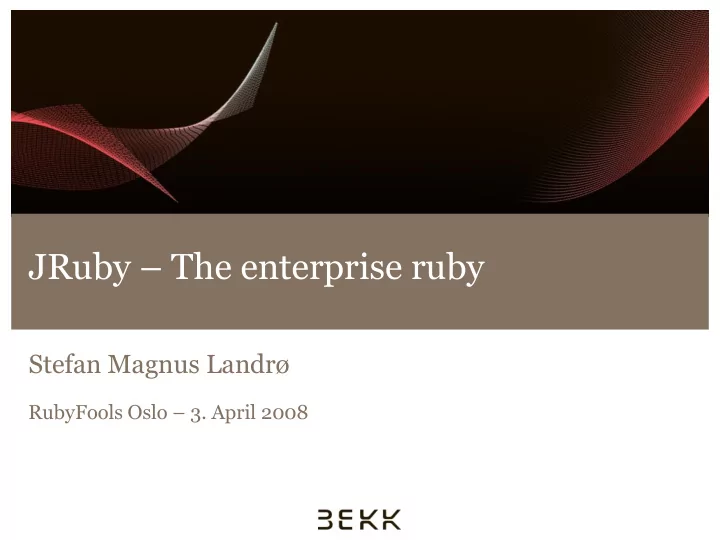

JRuby – The enterprise ruby Stefan Magnus Landrø RubyFools Oslo – 3. April 2008
Agenda Introduction to JRuby Java Integration JRuby on Rails Deployment Real life JRuby on Rails Q&A Side 2
Introduction - History JRuby is a Java implementation of the Ruby interpreter – Open Source project (CPL/GPL/LGPL) Originally created by Jan Arne Petersen, in 2001 – Direct port of the Ruby 1.6 C code Currently 4 core developers – Supporting ruby 1.8 semantics – Since JRuby 1.1 RC support for Just-In-Time compilation JRuby on Rails – Support for Rails since version 0.9 (May 2006) – Becoming better and better every day (especially due to Sun’s efforts) Side 3
Introduction - Performance Interpreted mode – Slower than the C Ruby Reference implementation – Rails: 50% to 70% slower Just-in-time compilation mode (1.1 RC) – Mostly faster than C Ruby 1.8 – Still slower than C Ruby 1.9 – Will approach or surpass performace of MRI in release version Side 4
Introduction – What’s cool about JRuby? Call ruby code from java (using JSR-223 alias Java Scripting) – Leverage language features found in ruby inside java programs – Ruby plugins in a java application – Scripting java appliations Call java code from ruby code (using the jruby interpreter) – Make use of company’s investment in java -code – Make use of open source java libraries when better/faster than ruby alternatives – Make use of commercial java libraries Deploy JRuby on Rails applications in a standard J2ee servlet container – Make use of existing company infrastructure (monitoring, management) Side 5
Java Integration Java Integration Side 6
Java Integration – Calling ruby from java Side 7
Java Integration – Accessing java classes Mapping of java classes in JRuby – Java: org.company.MyClass – JRuby: Java::OrgCompany::MyClass include Java / require ’java’ – directive gives access to standard java libraries import <fully.qualified.JavaClassName> – directive gives access to using class directly – works just like in Java include_package – import complete java package within a jruby module Side 8
Java Integration – Extending , adding, implementing Extending java classes in JRuby – Same syntax as for ruby classes Adding behaviour to java classes in JRuby (very powerful!) – Same syntax as for ruby classes Implementing java interfaces JRuby – Use include directive just like with mix-ins Using java classes that are not part of the standard library – Use require <my.jar> Side 9
Java Integration – Rubyfy it! Java accessors get rubyfied in JRuby – Java: instance.getSize() JRuby: instance.size – Java : instance.setSize(12) JRuby: instance.size = 12 Method name translation – Java: instance.myTerribleMethodName() – JRuby: instance.my_terrible_method_name Extensions to java classes – java.util.Map and java.util.Collection include Enumerable and each – And more features that make sense to a ruby programmer Side 10
JRuby on Rails Deployment JRuby on Rails Deployment Side 11
JRuby on Rails Deployment Can use standard C ruby setup (pack of Mongrels etc) More attractive to use Java application server/servlet container – Reuse existing infrasturcture (clustering, management, monitoring etc) – Preferred by bigger companies Currently three alternatives – Glassfish gem (Sun Application Server: Glassfish V3 – not quite stable yet) – Goldspike by JRuby Team – Warbler by Nick Sieger Uses Goldspike servlet internally, but uses different packaging and is more stable – Several other advantages (See Nick Sieger’s blog -post from 4. September 2007) – Side 12
JRuby on Rails Deployment - Warbler Create standard rails application – jruby -S rails rubyfools --database=mysql – jruby script/generate scaffold post title:string body:text published:boolean – jruby -S rake db:migrate RAILS_ENV=production – jruby script\server – eproduction (WEBrick) Add warbler to your installation – jruby -S gem install warbler SKIP! – Modify application.rb BUG? – jruby -S warble [war] – jruby -S warble war:clean Deploy it to your favourite java application server (e.g. Apache Tomcat) Side 13
JRuby on Rails Deployment - Warbler Possible to customize lots of things in warble.rb (jruby -S warble config) – Number of JRuby runtimes – Gems to be included – JNDI database pool Side 14
Real Life JRuby Real life JRuby Side 15
Real life JRuby 4-month prooof of concept project – 4 programmers No previous JRuby knowledge – very easy to learn Integration with company internal java-based software was very easy Netbeans v 6 adds good support for JRuby, Ruby and Rails development Problems – Serializing java objects in JRuby Solution: First serialize to a java String – – DRb didn’t work properly under JRuby Solution: quit using it – – JSR 223 JRuby engine implementation is buggy (no tests) Solution: fix it if you have to use it – Side 16
Conclusion Conslusion Side 17
Conclusion JRuby makes ruby enterprise ready Side 18
Conclusion +++ – Reusing sourcecode written in Java works perfectly – Deploying to a Java-based application server works flawlessly --- – Most C-based gems have not been ported to JRuby yet – Performance is behind MRI Side 19
References Practical JRuby on Rails – Web 2.0 Projects by Ola Bini JRuby Wiki – http://wiki.jruby.org user@jruby.codehaus.org (10-20 posts per day) Warbler – http://caldersphere.rubyforge.org/warbler/ – http://blog.nicksieger.com/articles/2007/09/04/warbler-a-little-birdie-to- introduce-your-rails-app-to-java Side 20
Questions & Answers Q & A Side 21
Recommend
More recommend